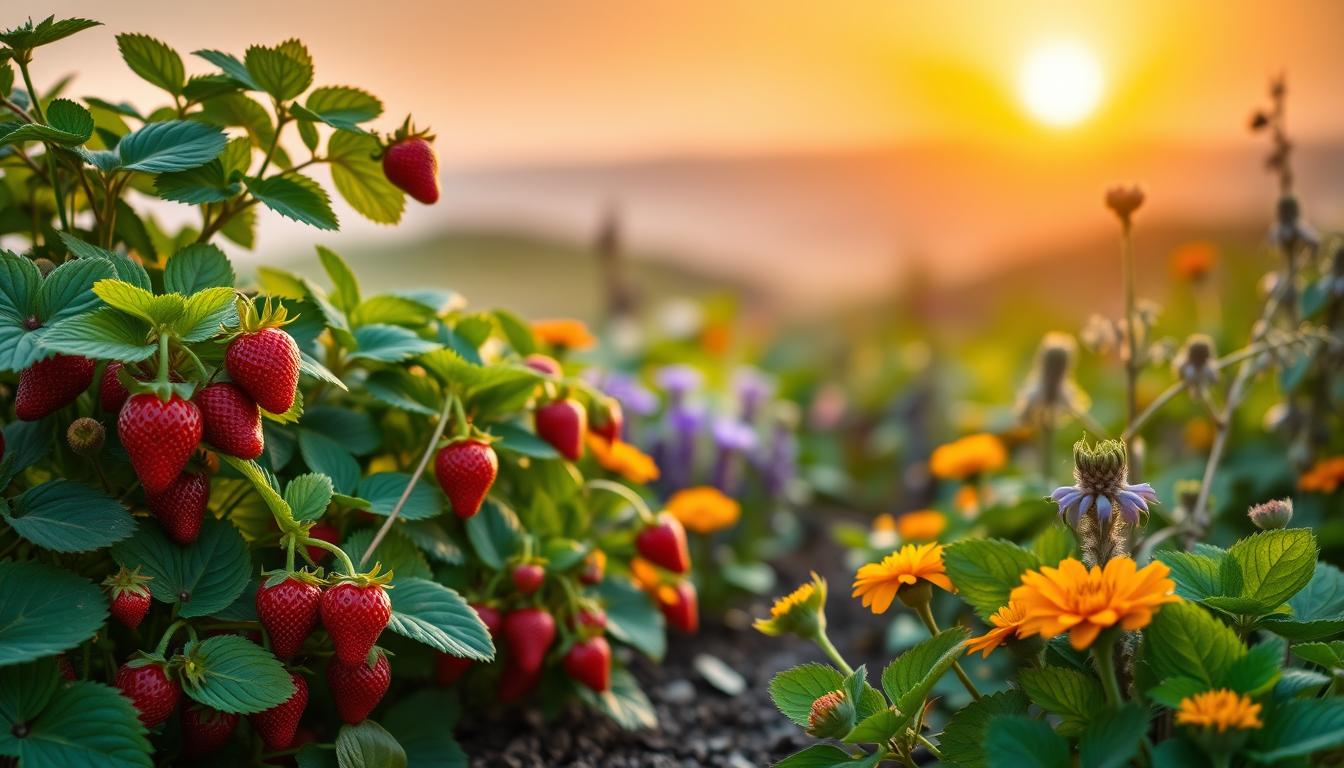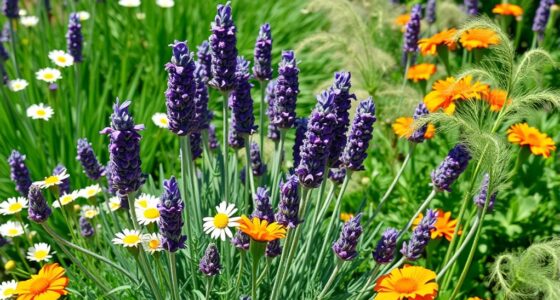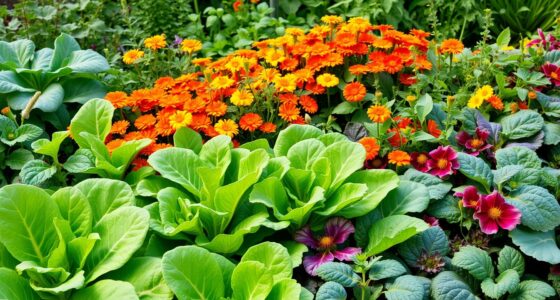Imagine stepping into your garden, where the vibrant smell of fresh strawberries dances with the earthiness of rich soil. Growing strawberries can be a delightful journey, but have you considered how the right strawberry companion plants can elevate your experience? By nurturing these incredible fruits alongside specific plants, you not only enhance their health but also create an oasis for beneficial insects and pollinators. Implementing organic companion planting for strawberries transforms your garden into a harmonious ecosystem. Join us as we explore the best companion plants for strawberries, ensuring a bountiful and sustainable harvest that you can cherish.
Key Takeaways
- Strawberry companion plants improve soil quality and health.
- They can attract beneficial pollinators to your garden.
- Careful selection of companion plants aids in pest control.
- Organic companion planting techniques enhance sustainable gardening.
- Choosing the right companions boosts strawberry flavor and yield.
Why Choose Companion Plants for Strawberries?
Companion planting serves as a valuable technique for boosting your gardening success, particularly when growing strawberries. By integrating different plant species, you create an environment that thrives through natural synergies. Exploring the benefits of companion planting can reveal surprising advantages that enhance your gardening experience.
Benefits of Companion Planting
Utilizing companion plants alongside strawberries offers myriad benefits. Certain plants can ward off pests while enhancing soil nutrients. For instance, marigolds release fragrances that repel unwanted insects, safeguarding your strawberry plants. Garlic can achieve similar results with its potent aroma. Ultimately, these natural deterrents lead to healthier crops and higher yields.
Enhancing Strawberry Flavor and Growth
Choosing the right companions can notably elevate the flavor of your strawberries. Some herbs, like basil and borage, not only support overall growth but also infuse strawberries with a richer taste. When you consider how to plant strawberries with companions, think about those that attract beneficial insects. Pollinators attracted by flowers improve strawberry production and flavor quality.

Ideal Companion Plants for Strawberries
Creating a fruitful strawberry garden involves more than just planting strawberries; selecting ideal companion plants can significantly enhance growth and protect against pests. Below are some excellent choices for your strawberry garden companion plants that promote a healthy and productive environment.
Marigolds: Natural Pest Repellent
Marigolds are a favorite among gardeners for their pest-repelling properties. By planting them alongside strawberries, you can keep pests like aphids and nematodes at bay. Their vibrant blooms not only add color to your garden but also help in maintaining healthier strawberry plants.
Borage: Boosting Strawberry Health
Borage is another fantastic option. This plant attracts beneficial insects and pollinators that contribute to your garden’s ecosystem. Borage also enhances soil health, ensuring your strawberries receive the nutrients they need to thrive. This makes borage one of the ideal companion plants for strawberries.
Thyme: Tasty and Beneficial
Thyme not only enhances your culinary dishes but also serves as a beneficial strawberry garden companion plant. Its aromatic presence can deter pests while providing habitat for pollinators. Incorporating thyme into your strawberry patch creates a synergistic effect, supporting the overall growth and flavor of your strawberries.
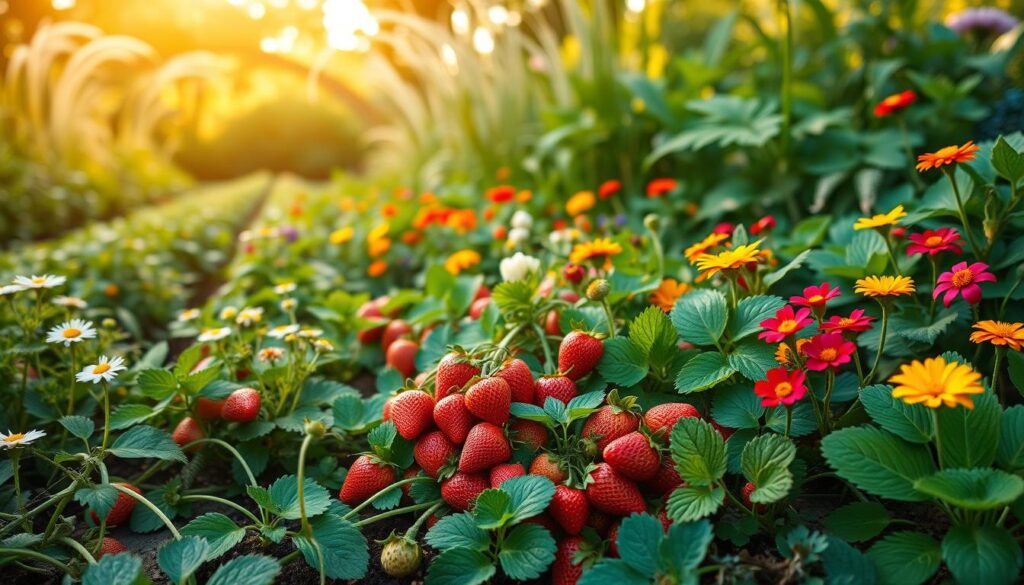
Herbs That Pair Well with Strawberries
Choosing the right herbs can enhance your strawberry garden’s productivity and flavor. The best companion plants for strawberries include a variety of herbs that not only complement the taste of strawberries but also provide pest management and attract beneficial pollinators. Two standout options are basil and oregano, which offer a wealth of benefits.
Basil: A Flavorful Match
Basil is a top choice when considering herbs that pair well with strawberries. Its aromatic qualities not only enhance culinary dishes but also help in repelling harmful insects that might threaten your strawberry plants. By planting basil alongside strawberries, you can enjoy flavorful harvests while keeping pests at bay.
Oregano: Health Benefits for Your Garden
Oregano is another excellent herb to include in your strawberry patch. This hardy herb can mask the scent of strawberries, providing a layer of protection from pests. Furthermore, oregano’s presence encourages pollinators to visit your garden, promoting overall health and vitality in your plants.
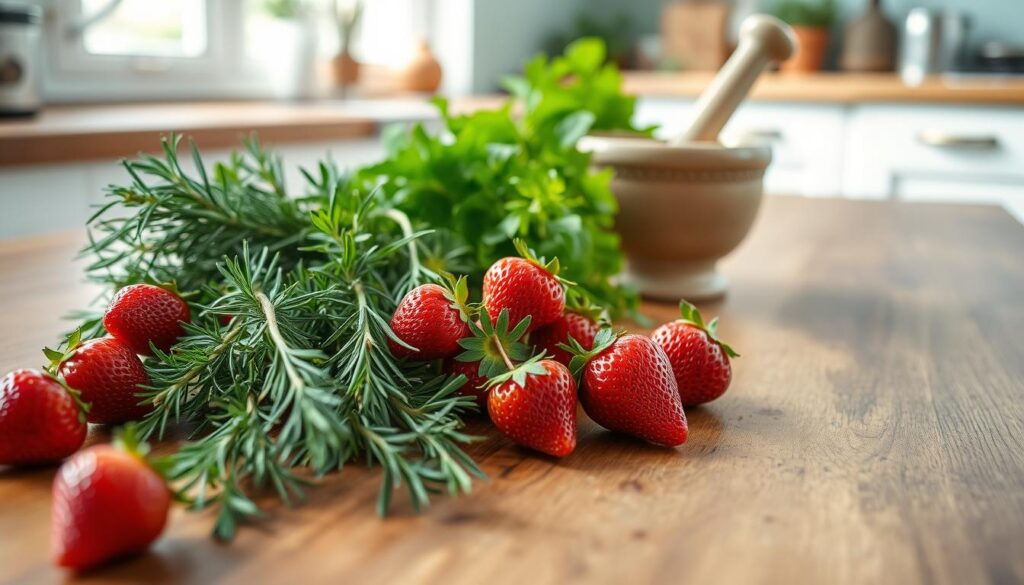
Vegetables That Thrive with Strawberries
Pairing strawberries with the right vegetables can bring harmony to your garden while maximizing space and resources. Understanding which vegetables thrive with strawberries helps you create a productive and flourishing setting. The companion planting chart for strawberries offers valuable insights into the best combinations.
Spinach: Space-Saving Companion
Spinach is an excellent choice when planting alongside strawberries. This leafy vegetable grows quickly and occupies minimal real estate, making it perfect for tight spaces. Its ability to suppress weeds allows strawberry plants to receive adequate sunlight and moisture. By planting spinach, you not only save space but also enhance the overall health of your garden.
Asparagus: Long-Term Growth Partner
Asparagus stands out as a long-term beneficial companion for strawberries. With its deep roots, asparagus does not compete for nutrients and water, allowing both plant types to thrive together. This partnership enhances the soil structure, as asparagus adds nitrogen back into the ground, creating a better growing environment for strawberries. Incorporating these vegetables that thrive with strawberries can significantly boost your garden’s productivity.
| Vegetable | Benefits with Strawberries | Growing Conditions |
|---|---|---|
| Spinach | Suppresses weeds and conserves moisture | Cool weather, partial shade |
| Asparagus | Improves soil nitrogen levels | Well-drained soil, full sun |
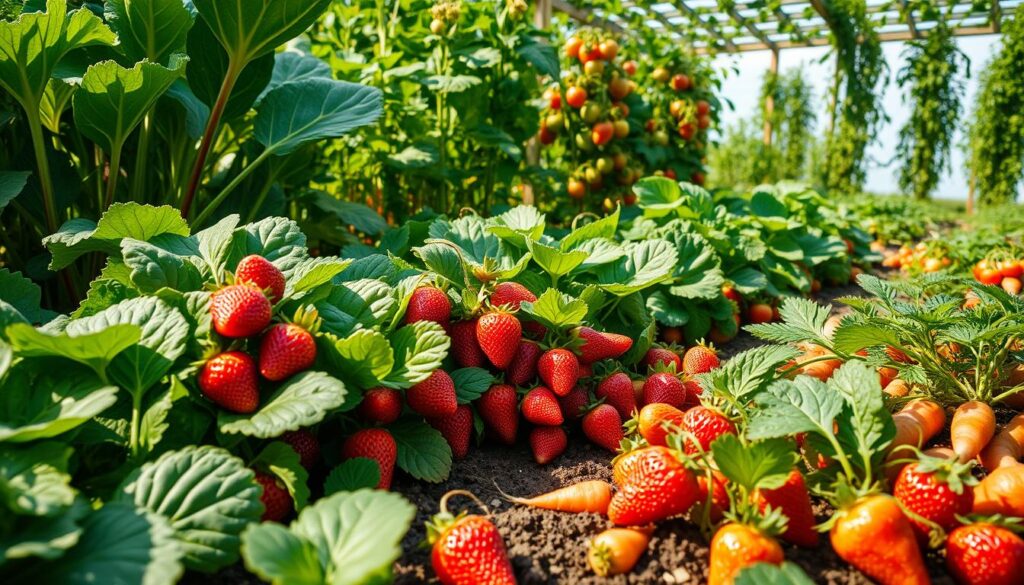
Fruits That Can Co-Grow with Strawberries
When considering fruits that can co-grow with strawberries, look no further than raspberries and blueberries. These fruits not only complement strawberries visually but also share similar growing requirements, ensuring a thriving garden environment.
Raspberries: Similar Needs and Support
Raspberries thrive in conditions like moisture and well-drained soil, characteristics that strawberries enjoy as well. This compatibility makes them ideal strawberry companion plants. They can share space without competing for nutrients, allowing both to flourish and produce delicious yields. Ensure adequate spacing for air circulation and access to sunlight for maximum benefits.
Blueberries: Acid-Loving Allies
Blueberries are another excellent choice for pairing with strawberries due to their preference for slightly acidic soil. Both fruits require similar care practices, making maintenance easier for gardeners. By combining these two acidic-loving fruits, you can create an environment that promotes healthy growth and enhances the overall fruit quality. This relationship can result in a diverse and fruitful garden.
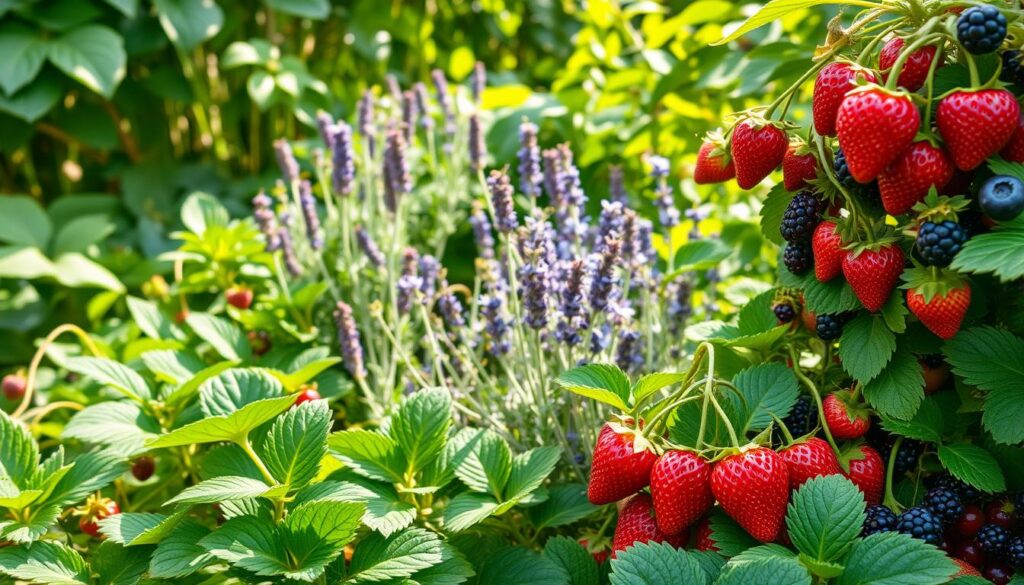
Flowers That Benefit Strawberry Plants
Incorporating flowers that benefit strawberry plants into your garden can significantly enhance their growth and health. These flowers not only add beauty to your space but also support the strawberries in various ways, such as attracting beneficial insects and deterring pests. Two standout options are nasturtiums and calendula.
Nasturtiums: Deterring Pests Naturally
Nasturtiums are a fantastic addition to your strawberry patch. Their peppery leaves and vibrant blooms are known for attracting beneficial insects, which can help reduce harmful pest populations. By planting nasturtiums alongside your strawberries, you create a natural barrier against pests that might otherwise threaten your precious fruit.
Calendula: Colorful and Helpful
Calendula is not only visually appealing with its sunny-colored flowers but also serves multiple purposes in your garden. These flowers attract pollinators, significantly boosting the productivity of your strawberry plants. Their presence enhances the overall ecosystem, making them one of the best strawberries companion plants you can choose.
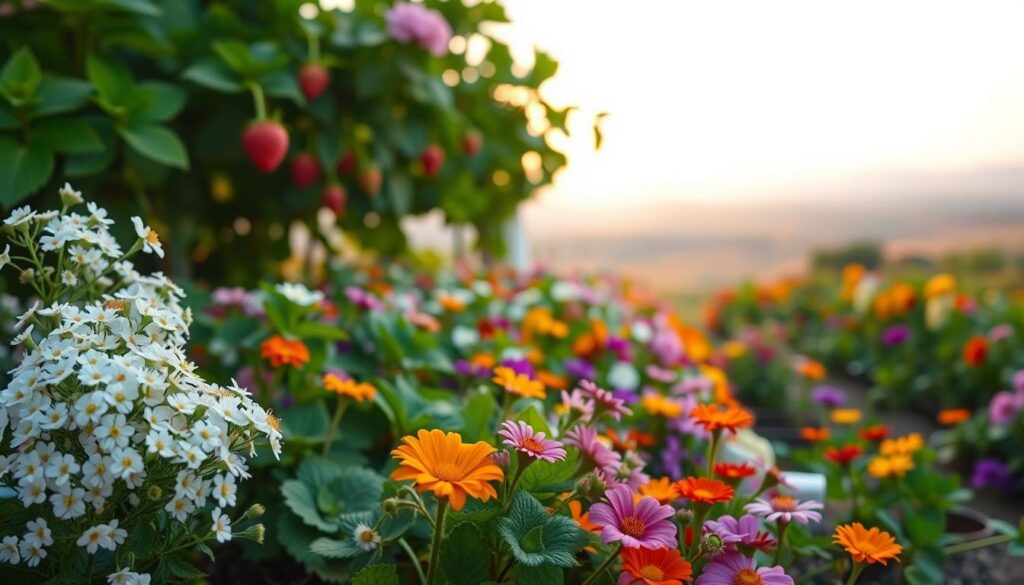
Plants to Avoid Near Strawberries
Growing strawberries can be rewarding, but understanding which plants to avoid can significantly impact your success. Certain species exhibit traits that hinder strawberry growth or make them susceptible to diseases. Knowing the bad companion plants for strawberries can help you cultivate a healthy garden.
Cabbage Family: Compatibility Issues
Members of the cabbage family, including cabbage, broccoli, and cauliflower, are among the plants to avoid near strawberries. These cruciferous plants compete for similar nutrients and water, leading to stunted growth in strawberries. Their dense foliage can also cast shade, limiting sunlight exposure essential for strawberry plants.
Potatoes: Risk of Disease Spread
Potatoes present a significant threat due to their potential to spread diseases such as verticillium wilt, which can severely impact strawberry health. Placing these two crops near each other increases the probability of disease transfer. Thus, potatoes rank high among the bad companion plants for strawberries.
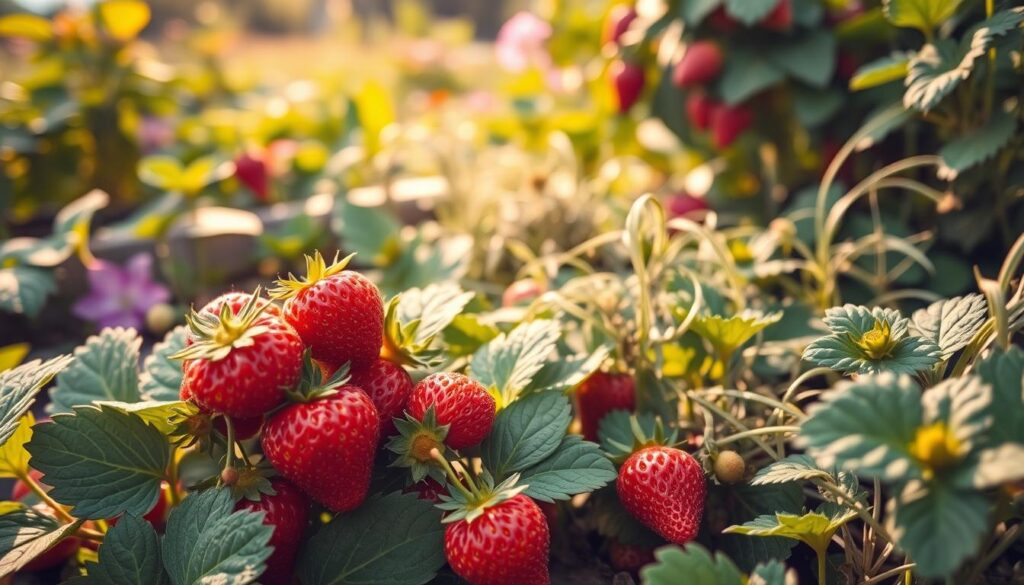
| Plant | Reason to Avoid |
|---|---|
| Cabbage | Competes for nutrients and water |
| Broccoli | Similar growth conditions, stunts strawberry growth |
| Cauliflower | Blocks sunlight and competes for resources |
| Potatoes | Risk of verticillium wilt spreading |
| Brussels Sprouts | May attract pests harmful to strawberries |
Soil and Water Considerations
Understanding soil and water considerations for strawberries is crucial for achieving a bountiful harvest. Strawberries thrive in well-drained, rich soil, which is essential for their overall health and productivity. This section explores the significance of proper soil composition and watering practices to ensure your strawberry plants flourish.
Importance of Well-Drained Soil
Strawberries do not perform well in waterlogged conditions, as excessive moisture can lead to root rot. The ideal soil for strawberry companion plants should allow excess water to drain away efficiently. Aim for a mix containing organic matter, such as compost or well-rotted manure, enhancing soil structure and fertility. This type of soil not only nourishes the roots but also supports microbial activity critical for plant health.
Consistent Watering Practices
Alongside great soil, consistent watering practices are vital for juicy, flavorful strawberries. During the growing season, particularly when fruit is forming, your plants require regular moisture. Aiming for about an inch of water per week helps maintain optimal soil moisture levels, ensuring adequate hydration without the risk of overwatering. Mulching around plants can further help retain moisture and regulate soil temperature.
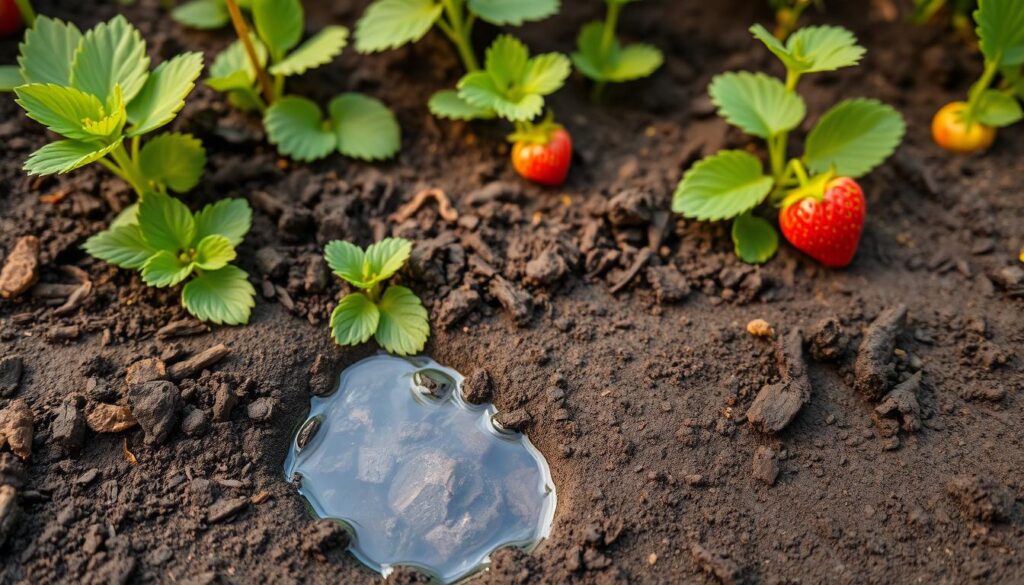
Pollinators and Beneficial Insects
Enhancing your strawberry garden involves more than just selecting the right companion plants. Attracting pollinators to your strawberry garden plays a crucial role in ensuring robust fruit production. Bees are primary pollinators and contribute significantly to the strawberry yield. By incorporating flowering plants, you can create a welcoming habitat for these essential insects.
Attracting Bees to Your Garden
Bees are drawn to vibrant flowers rich in nectar and pollen. To maximize their presence, consider planting:
- Sunflowers
- Lavender
- Cosmos
- Bee balm
These plants not only add beauty but also enhance the likelihood of attracting bees, which aids in facilitating better pollination of your strawberries.
Ladybugs: Nature’s Pest Control
While attracting pollinators is important for strawberry plants, beneficial insects for strawberry plants like ladybugs are equally vital. These small beetles feast on aphids and other pests harmful to your crops. Introducing ladybugs into your garden can lead to a healthier ecosystem. Consider these steps to attract ladybugs:
- Provide a water source, such as a shallow dish with pebbles
- Plant herbs like dill and fennel, which are known to attract ladybugs
- Avoid pesticides to create a safe environment for them
By fostering both pollinators and beneficial insects, you create a nurturing space for your strawberries to thrive.

Seasonal Care for Companion Plants
Understanding the seasonal care for strawberries is essential for nurturing a flourishing garden. Spring ushers in the best planting times for strawberry companions. This period allows you to cultivate a diverse array of plants that can enhance your strawberry patch while ensuring optimal growth.
Spring Planting Tips
During spring, it is crucial to pay attention to the specific needs of your companion plants. Start by preparing the soil with rich organic matter to enhance nutrients. When planning your garden layout, consider the best planting times for strawberry companions like marigolds and borage, which boost strawberry health by deterring pests and enriching the soil. Regular watering and monitoring for signs of disease will also contribute to a vibrant growing environment.
Winterizing Your Strawberry Patch
As winter approaches, it’s vital to protect your strawberry plants and companions from cold damage. Apply a thick layer of mulch around the plants to insulate roots against freezing temperatures. Cut back any dead or diseased foliage to ensure air circulation. By providing a stable environment during the harsh winter months, you set the stage for a bountiful yield in the following spring.
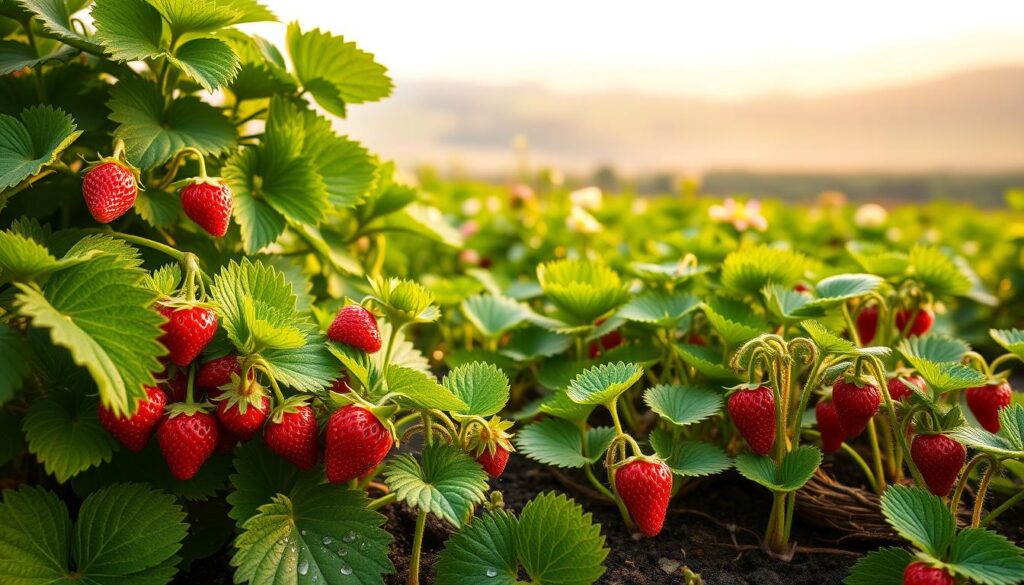
| Season | Action | Companion Plants |
|---|---|---|
| Spring | Plant and cultivate | Marigolds, Borage |
| Summer | Monitor growth and manage pests | Thyme, Basil |
| Fall | Harvest and prepare for winter | Nasturtiums, Oregano |
| Winter | Insulate and protect plants | None required |
Achieving a Harmonious Garden Design
Creating a beautiful and productive space for your strawberries involves thoughtful garden design for strawberry planting. Implementing effective planting patterns can significantly enhance growth while ensuring a harmonious garden with companion plants. Various strategies can optimize both light and space use in your garden, paving the way for more fruitful yields.
Planting Patterns to Enhance Growth
When planning your garden, consider the arrangement of your strawberry plants alongside their companions. Effective spacing allows air circulation and sunlight penetration, promoting healthy growth. Here are some popular patterns to consider:
- Intercropping: Position strawberries between taller plants, such as corn or sunflowers, to maximize space and light.
- Block Planting: Group strawberries with compatible herbs or flowers to create a visually stunning and productive patch.
- Row Planting: Plant strawberries in rows and alternate with companion plants, ensuring they receive adequate air and sunlight.
Creating Shelter and Sunlight Balance
Protecting your strawberry plants from harsh weather conditions is crucial. Providing shelter can be achieved through strategic placement of companion plants, which can act as natural barriers against wind and intense sunlight. Consider these benefits:
- Windbreaks: Using taller plants like sunflowers can shield strawberries from damaging winds.
- Shade Management: Positioning shade-tolerant plants near the strawberries can help prevent heat stress during hot summer months.

Implementing these garden design strategies will lead to a more fruitful, balanced environment for your strawberries and their companion plants. Take the time to evaluate your garden layout, and you’ll reap the rewards of a thriving, harmonious garden with companion plants.
Organic Methods for Pest Control
Creating a thriving strawberry garden involves not just planting but also protecting your crops from pests. Using organic pest control for strawberries ensures a naturally healthy environment while minimizing harm to beneficial insects. By integrating companion plants and employing natural remedies, you can effectively manage garden pests without harmful chemicals.
Natural Remedies for Common Pests
Common garden pests can wreak havoc on your strawberry plants. Explore these natural remedies to maintain a healthy garden:
- Neem oil: This oil disrupts the life cycle of many pests and acts as a repellent.
- Garlic spray: A homemade garlic spray can deter aphids and other pests.
- Soap solution: Mild soap mixed with water can effectively eliminate soft-bodied insects like spider mites.
Companion Plants That Repel Insects
Incorporating certain companion plants acts as a form of organic pest control. These plants can naturally deter unwanted pests:
- Marigolds: Their scent repels nematodes and many other harmful insects.
- Thyme: This herb not only enhances flavor but also attracts beneficial insects that prey on pests.
- Nasturtiums: These flowers serve as a trap crop, drawing pests away from strawberries.
Incorporating these techniques will lead to a flourishing and productive strawberry garden, while promoting environmental health through organic practices.
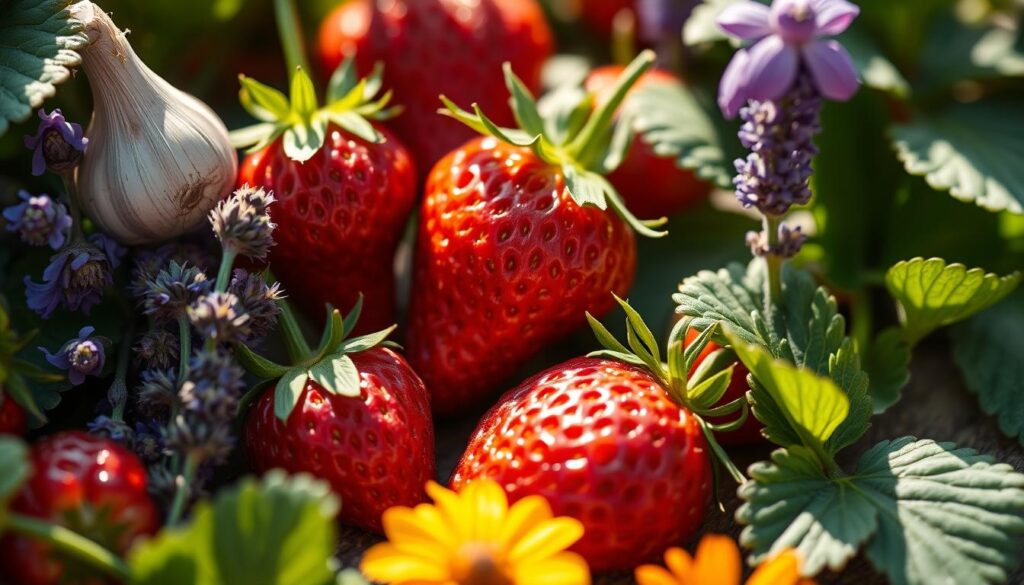
Educational Resources for Companion Planting
Enhancing your knowledge of companion planting can significantly improve your gardening experience. Numerous educational resources for companion planting exist to guide you in creating a thriving environment for your strawberries and their companions. Whether you prefer the written word or engaging with fellow gardening enthusiasts, these resources offer valuable insights and community support.
Books and Guides for Gardeners
Books are excellent tools for learning about the principles and practices of companion planting. They provide in-depth information, strategies, and recipes for creating a successful garden. Recommended titles include:
- Carrots Love Tomatoes by Louise Riotte
- The Companion Planting Garden by Anna Hess
- Companion Planting for Beginners by R. Kelly
Each of these works offers different perspectives and methodologies, ensuring you find the strategies that best fit your garden’s unique needs.
Online Communities and Forums
Engaging in gardening communities provides real-time interaction with other gardeners. These online forums and social media groups serve as platforms to share experiences, ask questions, and learn from one another. Some popular platforms include:
- Reddit’s r/gardening community
- The Gardening Channel on Facebook
- Garden Web Forums
Connecting with these communities can inspire new ideas and offer practical advice tailored to your local climate and conditions.

By utilizing these educational resources for companion planting, you can enrich your gardening journey and cultivate healthier, more productive plants.
Conclusion: Crafting Your Ideal Strawberry Garden
As you look to cultivate your ideal strawberry garden, remember that carefully selecting companion plants can have a profound impact on the overall health and yield of your strawberries. The power of companion planting offers numerous benefits, from attracting beneficial insects to enhancing flavor. By pairing your strawberries with the right plants, you can create a thriving ecosystem in your garden that supports growth and vitality.
Final Thoughts on Companion Planting
Utilizing the insights from this article will equip you with essential knowledge for crafting your ideal strawberry garden. Consider the various companion plants that enhance your strawberries’ well-being and mitigate challenges like pests. This approach not only promotes successful gardening but adds diversity to your patch, making the process more enjoyable.
Encouragement to Experiment and Enjoy
Don’t hesitate to experiment with different combinations of companion plants in your strawberry garden. Each season offers an opportunity to refine your strategy and learn what works best for your specific environment. Embrace this journey, relish the beauty of your flourishing plants, and savor the delicious fruits that come from your efforts. Happy gardening!
